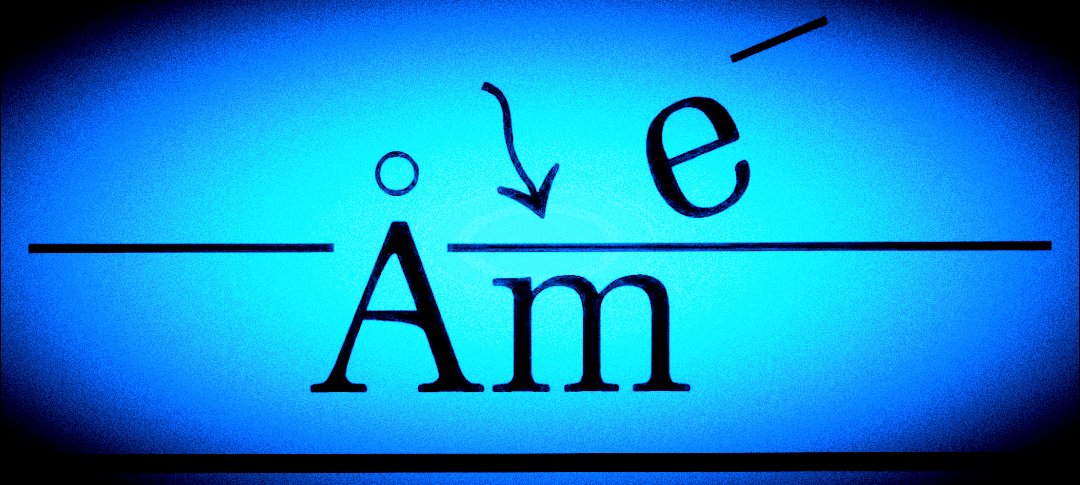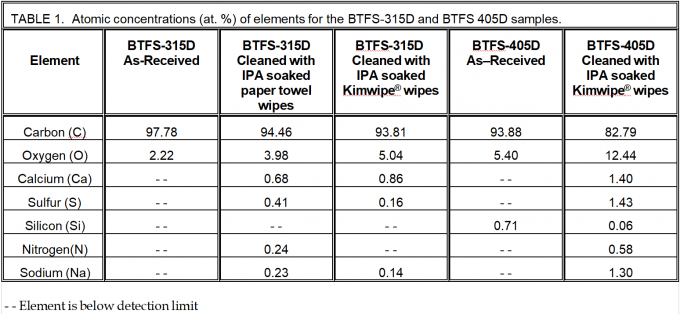Polyethylene Fiber Samples
Two polyethylene fiber samples were submitted to analyze the fiber surface chemistry of both the coatings and the underlying polyethylene fiber surfaces. The samples were labeled BTFS-315D and BTFS-405D. Both the BTFS-315D and the BTFS-405D were analyzed using XPS as-received and also after cleaning the fibers with a Kimwipe® saturated with isopropyl alcohol (IPA) followed by a rinse with IPA. This fiber surface cleaning process was repeated on a second sample of the BTFS–315D sample using a saturated paper towel with IPA. This cleaning was done to determine if the fiber surfaces were coated with other organic materials or were substantially contaminated. The samples prepared from each method were then mounted on a sample holder and analyzed using XPS.
XPS Analysis and Results
The XPS analysis of the polyethylene surface chemistry was performed over an elliptical area irradiated by the low-energy (1487 eV) monochromatic aluminum Kα x-ray with a major axis of 1.2 mm and a minor axis of 0.6 mm. This is an area of approximately 0.6 mm2. A wide-angle input lens, hemispherical analyzer, and a multi-channel detector make the spectrometer very efficient. The depth of the analyzed volume is about 8 nm, which is determined by the small mean-free path of the emitted photoelectrons. The elemental survey spectra cover the binding energy range from 0 to 1100 eV, with a step size of 0.5 eV. This step size, with the monochromator, the moderate analyzed area size, and a high signal-to-noise ratio, improves the quantitative accuracy and sensitivity beyond industry standards. The XPS system consists of a turbomolecularly pumped introduction chamber, an ion pumped sample preparation chamber, and an analysis chamber which is also ion pumped. When samples are inserted into the Analysis Chamber, they pass through the Preparation Chamber, which decreases the exposure of the Analysis Chamber to water vapor and hydrocarbons from the Introduction Chamber. We also make a practice of segregating the samples of different customers to minimize cross contamination.
The BTFS-315D as-received sample surface was almost entirely composed of carbon (97.78 at.%), with the remainder being oxygen (2.22 at.%), as given in Table 1. The as-received BTFS-405D sample surface contained a slightly lower carbon content (93.88 at.%), more oxygen (5.40 at.%), and a small concentration of silicon (0.71 at.%), also in Table 1. Both of the as-received sample surfaces were primarily composed of carbon and oxygen.
The BTFS-315D sample was wiped with paper towel soaked in IPA about 10 times and further rinsed with IPA. The surface of the fibers now revealed a different composition, indicating the removal of a surface layer of organic material and the exposure of more of the stronger fiber material. This sample contained carbon (94.46 at.%), oxygen (3.98 at.%), calcium (0.68 at.%), sulfur (0.41 at.%), nitrogen (0.24 at.%), and sodium (0.23 at.%). Sometimes calcium and sulfur are found in papers and finding that they had appeared here caused concern that they might be contaminants from the paper towel. In the past, similar, but not the same manufacturer’s paper towels had not contributed such contamination. Nonetheless, it seemed wise to try a laboratory wipe known for its lack of possible contaminants, Kimwipes®.
The BTFS-315D sample was wiped with a Kimwipe soaked in IPA about 10 times and further rinsed with IPA. The same elements were detected in the surface of the wiped fibers, except for nitrogen. The oxygen and calcium concentrations both increased, while the sulfur and sodium concentrations decreased. This may have more to do with the amount of surface material removed by the slight abrasion of the Kimwipe upon the surface and any solvent activity of the IPA on the surface coating material.
The BTFS-405D sample was also wiped with Kimwipes saturated in IPA 10 times and then further rinsed with IPA alone. The surface of the remaining fibers had a much higher oxygen concentration at 12.44 at.%. Even the outside as-received surface had a higher oxygen concentration than had the as-received 315D sample. After stripping away the surface layer on the 405D sample, the calcium (1.40 at.%), sulfur (1.43 at.%), and sodium (1.30 at.%) concentrations were all rather high. We also detected nitrogen (0.58 at.%) in two distinct chemistries and silicon (0.06 at.%).
The calcium may be from calcium stearate. Calcium stearate is commonly used as a lubricant for wire and filament drawing and for extrusion operations. Its lubricant properties help reduce extrusion pressure build-up and also minimize fiber breakage during the extrusion. Furthermore, sulfur is a component of some lubricants used in cold–drawing and extrusion processes. These materials or traces of them may have been left on the polyethylene fiber surface and were then coated over with a surface coating. Polyvinyl acetate or polyvinyl alcohol are commonly used to coat organic fibers to make them easier to handle and to put on spools, for instance, but both of those materials would have a higher oxygen concentration than the observed coatings do. This coating is more like a wax or oil. We could perhaps remove this coating material with solvents and then evaporate the solvent to leave a thicker layer of the coating material for FTIR analysis.
If the surface coating layer is very thick, it may have a considerable affect upon the processing of the 3-dimensional weave and its consolidation through sintering. The final sintered polyethylene block may have enough additive material from the coating on the fibers to have a significant effect on the ballistic absorption characteristics of the final product.
Conclusions
• The fibers have an easily stripped surface layer.
• The coated surface layer of the 315D sample is 97.78 at.% carbon and 2.22 at.% oxygen.
• The coated surface layer of the 405D sample is richer in oxygen concentration at 5.40 at.% and has a small concentration of silicon (0.71 at.%), perhaps due to a silicone or a silane coupling agent.
• After stripping the surface coating off the polyethylene fiber surface of the 315D sample, we found the oxygen concentration to more than double, and concentrations of Ca, S, N, and Na ranging from 0.68 at.% down to 0.23 at.%.
• The stripped 405D sample polyethylene fiber surface had an oxygen concentration which more than doubled to 12.44 at.%. The sulfur, calcium, and sodium concentrations ranged from 1.43 to 1.30 at.%. Nitrogen in two chemical states and a trace of silicon were detected.
• The surface coatings may affect the handling of the fiber materials. If they are thick enough, as the DSC findings indicate they are, they are likely to also affect the consolidation of the block polyethylene from the 3-dimensional weave and to affect the ballistic absorption properties of final product.
• The surface coatings may be oils or waxes given the low oxygen to carbon ratios. They are not the commonly used fiber coating materials polyvinyl alcohol or polyvinyl acetate.


